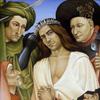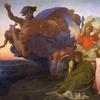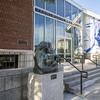Clark Art Institute Exhibition Presents Trailblazing Women Artists
- WILLIAMSTOWN, Massachusetts
- /
- May 02, 2018
The Clark Art Institute’s summer 2018 exhibition, Women Artists in Paris, 1850–1900, celebrates an international group of artists who overcame gender-based restrictions to make extraordinary creative strides, taking important steps in the fight for a more egalitarian art world. Featuring nearly seventy paintings drawn from prominent collections across the United States and abroad, the exhibition includes works by renowned artists including Berthe Morisot, Mary Cassatt, and Rosa Bonheur as well as their equally remarkable peers such as Anna Ancher, Lilla Cabot Perry, Louise Breslau, Eva Gonzalez, and Marie Bashkirtseff. Women Artists in Paris, 1850–1900 was organized by the American Federation of Arts and curated by Laurence Madeline. The Clark Art Institute will be its final venue, where it will be on view June 9–September 3, 2018.
“Given some of the issues around gender equality that are at the forefront of our current cultural discourse, this exhibition is both particularly timely and long overdue,” said Olivier Meslay, the Felda and Dena Hardymon Director of the Clark. “It is important to recognize that the struggles these women confronted more than 150 years ago continue to resonate today. It is quite moving to see these remarkable paintings and consider the strength and power of the artists who produced them. We trust that our visitors will delight in making new discoveries and will be fascinated by this still relatively untold history.”
“At this moment in time, it is more important than ever to recognize the achievements of these women,” said Esther Bell, the Clark’s Robert and Martha Berman Lipp Senior Curator. “This exhibition is a celebration of the extraordinary talent of a multinational group of women artists that deserve their rightful place in the canon of art history.”
In the mid-nineteenth century, Paris was a cultural mecca, luring artists from around the world to its academies, museums, salons, and galleries. Despite the city’s cosmopolitan character, gender norms remained strikingly conservative and women painters faced obstacles not encountered by their male counterparts. For example, the École des Beaux-Arts (Academy of Fine Arts)—the country’s most important art academy—did not admit female students until 1897.
As a result, women pursued art education by attending private academies, where they produced a wide array of work including portraits, landscapes, history paintings, and scenes from everyday life. In order to advance their art, they exhibited independently and formed their own organizations, such as the influential Union des Femmes Peintres et Sculpteurs (established in 1881).
Following their time in Paris, many artists, including Harriet Backer (Norwegian, 1845–1932), Kitty Kielland (Norwegian, 1843–1914), and Cecilia Beaux (American, 1855–1942), returned to their home countries to work, teach, and establish their own schools, creating the foundations for the training and development of future generations of women artists.
The Art of Painting
Depictions of artists in the studio, self-portraits, and representations of one artist by another are a familiar topic in the history of art. Women painters in the nineteenth century engaged in portraiture, as was common among their male peers, shaping an image of themselves and their contemporaries not as hobbyist painters but as serious artists. In the Studio (1881) by Marie Bashkirtseff (Ukrainian, 1858–1884) captures a life-drawing class at the Académie Julian, one of the few studios that welcomed women, although in gender-segregated classrooms. Other paintings such as the arresting Rosa Bonheur (1898), by her companion Anna Elizabeth Klumpke (American, 1856–1942), Elizabeth Nourse’s (American, 1859–1938) defiant Self-Portrait (1892), and Louise Breslau’s (Swiss, 1856–1927) intimate portrait of herself with friends, The Friends (1881), define the quality and variety of work produced during this period.
The Lives of Women
Social restrictions hindered women’s full participation in artistic circles. Taboos against women being in public without a chaperone limited their access to certain spaces and narrowed the range of subjects they could represent. As a result, many women artists focused on intimate scenes of daily life for which models were more readily accessible. Although domestic subjects have been considered secondary or negligible by some critics, the ways in which these artists treated their subjects were often innovative and unexpected, as in Backer’s Evening, Interior (1890) with its great attention to surface detail and careful rendering of light and atmosphere.
Fashioning an Image
A fashionable toilette—the ritual of bathing, applying cosmetics and perfume, and dressing—was fundamental to nineteenth-century social life for the middle and upper classes, and images of the modern woman exhibiting her fashion sense abounded. Clothing was seen as an embodiment of modernity, and painters—both male and female—seized upon the depiction of contemporary dress as a novel subject. Artists attempted to decipher what fashion, through its complex visual codes, had to say about the wearer and her world. Morisot’s The Sisters (1869), a double portrait of the artist and her sister Edma, was probably painted shortly after Edma married and left her family’s home. Morisot used clothing and coiffure to communicate the sisters’ intimacy; they are wearing matching dotted dresses replete with beautifully rendered frilled collars and sleeves, their upswept hair is similarly styled with ringlets and both have black chokers around their necks.
Rendering the details, sheen, or transparency of various fabrics allowed the painter to demonstrate technical mastery. Cecilia Beaux’s masterpiece in white, Sita and Sarita (Woman with a Cat) (1893–1894), depicts the artist’s cousin Sarah Allibone Leavitt. Through a bravura handling of pigment, Beaux imbues her subjects with wit and intelligence.
Picturing Childhood
In the late eighteenth century, the perception of childhood evolved as an important stage in the formation of healthy adults, and children were celebrated as the future of a family’s line. This new attention lavished on children coincided with the burgeoning aspirations of women artists. These painters produced images that poignantly celebrate the wonder of childhood and the profound nature of motherhood. Mary Cassatt specialized in maternal scenes and portraits of children. Her Children Playing on the Beach (1884) embodies the enchanted first years of life, depicting two toddlers absorbed in their play and seemingly isolated from the world.
A Modern Landscape
During the late nineteenth century, artists pushed the boundaries of landscape painting, participating in and helping to define artistic movements such as Realism, Impressionism, and Symbolism. They engaged more broadly with the modern world by featuring landscapes with which they had a connection, such as Paris’s public parks and private gardens, the modern city, the resort beaches of Normandy and Brittany, or the familiar landscapes of their own countries. Of particular interest in the exhibition is a selection of paintings by a group of remarkable Scandinavian artists. Landscapes such as Stokkavannet (1890) by Kitty Kielland and Autumn at Strålsjøen (1894) by Harriet Backer capture the grandeur and mystery of their homeland. Emma Löwstädt-Chadwick (Swedish, 1855–1932) beautifully illustrates the solitude of an artist painting en plein air in Beach Parasol, Brittany (Portrait of Amanda Sidwall) (1880).
History Painting and Everyday Heroism
History painting was traditionally reserved for male artists who had unlimited access to studying the human figure. The paintings in this exhibition highlight the artistic skill and bold creativity of women painters who found heroic subject matter in the world around them. Careful observation, confident brushwork, and sizeable canvases served to elevate subjects—including workers, military recruits, and Sunday churchgoers—into monumental narratives worthy of reflection and admiration by fellow artists, critics, and the public. In eschewing traditional history painting, these artists celebrated a time of change and promise.
Rosa Bonheur was a pioneer among her contemporaries. As was required at the time, she acquired special permission from the police to wear pants in public and painted “masculine” subjects such as agriculture and hunting scenes, but was most celebrated for her depictions of animals, including cattle, horses, and lions. Bonheur painted the massive Plowing in Nivernais (1850) as a replica of another of her paintings, which was commissioned by the French state and completed in 1849. The power of her depiction of cattle plowing is amplified by the monumental size of the canvas, which measures nearly 4.5 x 8.5 feet.
Jeunes filles
Jeunes filles—young women between childhood and adulthood—became an important theme in late nineteenth-century painting. Women artists often depicted this transitional moment, painting social relationships and reflective moments that were hallmarks of self-awareness.
Women Artists in Paris presents a number of paintings showing young women engaged in everyday tasks, be it sharing a secret as in La Confidence (c. 1880) by Elizabeth Jane Gardner Bouguereau (American, 1837–1922) or picking cherries in Morisot’s The Cherry Tree (1891). Echo (1891) by Ellen Thesleff (Finnish, 1869–1954) depicts a girl finding the power of her voice in a sudden cry as it resounds against the landscape.
Public Programs
In a lecture on June 10 at 3:00 pm, curator Esther Bell will speak about the remarkable achievements of the artists represented in the exhibition, as well as the barriers they encountered in their artistic education and later careers. A conversation with Laurence Madeline, Chief Curator for French National Heritage, and curator of Women Artists in Paris, follows the lecture.
The Clark will offer daily gallery talks from July 1–August 31, at 3:30 pm. Visitors can learn more about the incredible female artists who worked in France during the second half of the nineteenth century and about the obstacles they overcame to pursue their careers in the arts. These talks are offered at no additional cost and are limited to twenty people each on a first-come, first-served basis.
Exhibition and Catalogue Organizers and Sponsors
Women Artists in Paris, 1850–1900 is organized by the American Federation of Arts. Guest curator Laurence Madeline, Chief Curator for French National Heritage, was aided by Suzanne Ramljak, AFA Curator, and Jeremiah William McCarthy, AFA Associate Curator. Presentation of the exhibition at the Clark is coordinated by Esther Bell, Robert and Martha Berman Lipp Senior Curator at the Clark.
The exhibition is generously supported by the National Endowment for the Arts and by an indemnity from the Federal Council on the Arts and the Humanities. Additional funding is provided by the JFM Foundation, Elizabeth K. Belfer, the Florence Gould Foundation, Monique Schoen Warshaw, the Barbro Osher Pro Suecia Foundation, the Swiss Arts Council Pro Helvetia, Clare McKeon, Steph and Jody La Nasa, Victoria Ershova Triplett, the American-Scandinavian Foundation, and the Finlandia Foundation. Support for the accompanying publication provided by Furthermore: a program of the J.M. Kaplan Fund.
Presentation of Women Artists in Paris at the Clark is made possible by the generous contribution of Denise Littlefield Sobel, with additional support from the Dr. Lee MacCormick Edwards Charitable Foundation.













